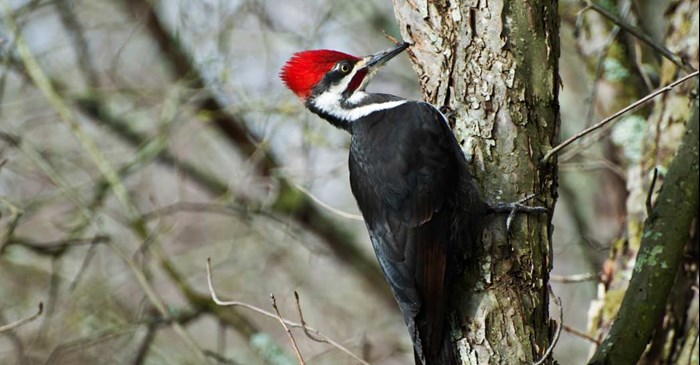The Pileated Woodpecker is a showy bird among colorless winter landscapes. The largest of the North American woodpecker species, they are black, with bold white stripes on the face and flanks. “Pileated” (PIE-lee-ay-tid) means “capped,” and refers to that smart crest of red feathers on its head. Read on to learn more about this visitor to winter bird feeders.
The hammering of the Pileated Woodpecker
What’s noteworthy about the Pileated Woodpecker is its strong bill, which is as long as its head, a sturdy chisel that sends woodchips flying through the air, leaving behind telltale rectangle-shaped markings in the wood. In the spring, they use their bills to carve out nesting holes in the softwood of dying and decaying trees, which are later occupied by swifts, owls, ducks, bats, and Pine Martens as shelter.
The Pileated Woodpecker spends much of its summer in mature trees, hammering away, following the tunnels left by their main food source, carpenter ants. With their barbed tongues, they retrieve beetle larvae from inside the trees. As they work, other birds, especially wrens, draw near to feed on the escaping insects.
Where does the Pileated Woodpecker live and what do they eat?
The territory of the Pileated Woodpecker makes a lopsided horseshoe shape across North America, blanketing much of the eastern half of the U.S., spanning Canada, then needling along the coast of the Pacific Northwest. Though their populations plummeted with the loss of old-growth deciduous forests to land development, the Pileated Woodpecker has adapted to living alongside humans, which has helped them rebound. As part of this adaptation, they can be found in new-growth woods in suburban areas.
Backyard tips for the Pileated Woodpecker
Dead and dying wood is critical to the Pileated Woodpecker’s habitat but can be in short supply near housing developments. The Pileated Woodpecker rarely takes to nesting boxes, but if you live adjacent to a wooded area, give it a try. Mount the box on a tree in late winter, and pack it with sawdust and wood shavings so the birds can excavate their own opening.
If you’re an avid watcher of the bird feeder, the arrival of colder weather means the start of woodpecker viewing season. Woodpeckers are non-migrants, so when the insect supply disappears, they instead forage for seeds, nuts, and fruits. Fill your feeder with Lyric Woodpecker No Waste Mix and enjoy the close-up look at this showstopping bird.
